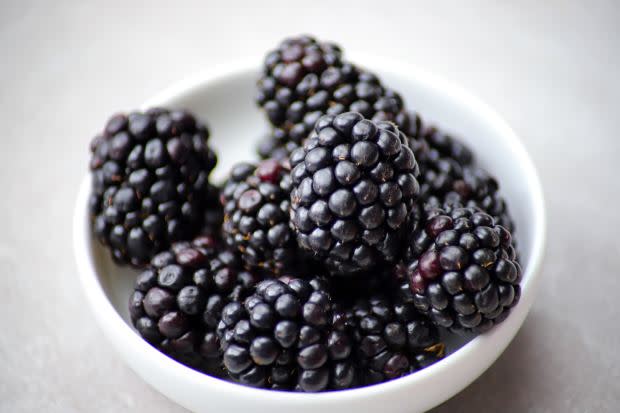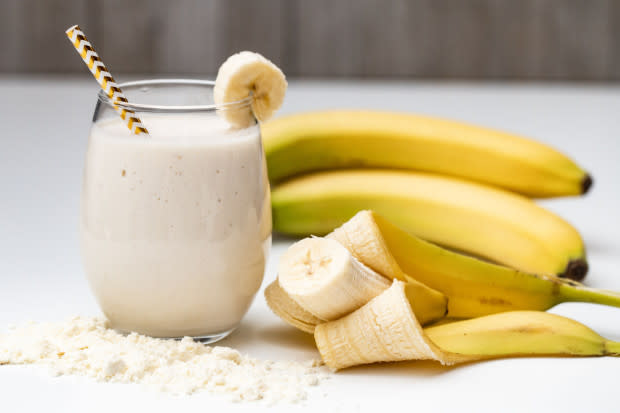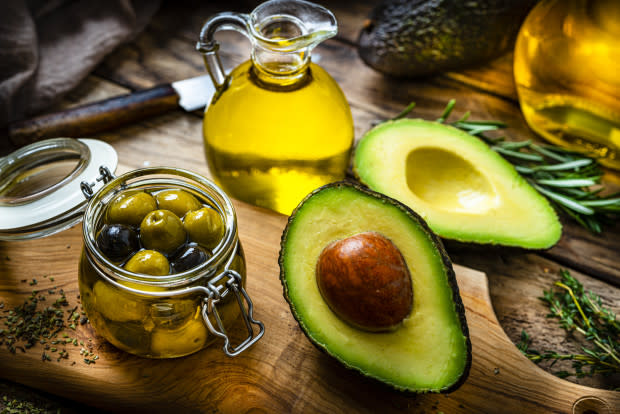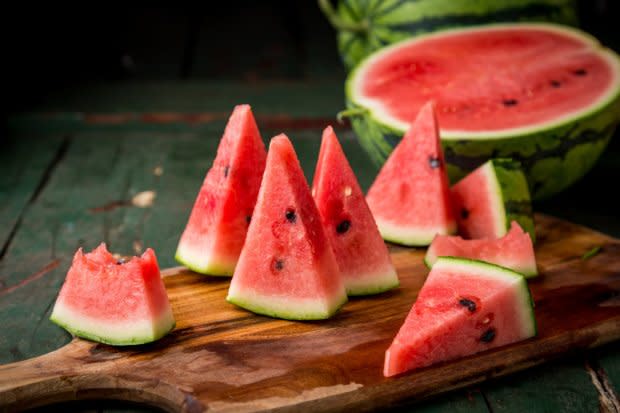Berries With Best Health Benefits According to Nutritionists
Blueberries, strawberries, blackberries, raspberries. We all think we have a pretty good idea of what a berry is. We love berries with our dessert or in our French toast. But what we may not know is that the berry variety and range is far wider than we could have ever imagined.
While people may only think of fruit with the word "berry" in it as berry options, there are actually around 400 varieties of foods that are considered berries. And some types of berries are pretty surprising. “A berry is a fruit with seeds, so along with the obvious raspberry and blackberry, options like watermelon and kiwi are berries too. Berries will provide nutrients to a diet, and can be a positive part of a healthy lifestyle,” explains Lauren Manaker, MS, RDN, LD.
Scientifically, berries might not be what they seem.
Generally, a diet that is rich in vegetables and fruits, including berries, will support health. “These foods contain a wide variety of vitamins, minerals, antioxidants and phytochemicals that can boost well-being in various ways. Fruit is also a great source of fiber, which is important for a healthy digestive system and a healthy gut, which is at the core of vitality and well-being (a healthy gut microbiome supports heart health, mental health, and immune function),” says Serena Poon, a celebrity chef and nutritionist.
Berries are so tasty and can add a touch of freshness and sweetness to anything from a salad to a yogurt parfait. But they also have serious health value. Consuming almost any kind of edible berry fills you up with powerful antioxidants that can do amazing things like prevent cognitive decline and fight cancerous cells. Berries are also relatively low in sugar and high in fiber, which can help to regulate blood sugar levels and reduce the risk of type 2 diabetes.
Related: 17 Delightful Berry Recipes
What is a berry?
The way you have always mentally defined a berry may be about to change. “A berry by its botanical definition is a fleshy fruit that develops from a single ovary of a single flower and has seeds embedded in the fruit,” says Tanya Mezher, MS, RD, CDN Lead Functional Practitioner at Malla.
How many types of berries are there?
Because this definition is relatively broad, there are literally hundreds of fruits that could technically be considered a berry. The non-obvious ones most would not consider berries actually include grapes, bananas, avocados, watermelon, pumpkins, papayas, etc., by the botanical definition. But there are so many other members of the berry family, from acai berries to Barbados cherries to elderberries, goji berries, golden berries, gooseberries, huckleberries, kiwi berries and lingonberries. We can go on for a very long time!
Is a watermelon a berry?
Yes, you read that right. Watermelon is a berry! “It grows from a single ovary of a single flower and has many seeds in it. Watermelons are actually in a subclass of berries, called pepos, that have a tough exterior and fleshy interior,” Mezher says. Other pepos include cucumbers and pumpkins.
More interesting is that fruits that are generally categorized and popularly enjoyed as berries, such as strawberries and raspberries are not—by the botanical definition—true berries, in the most authentic of berry senses. “They are considered ‘aggregate fruits’ since they grow from multiple ovaries of a single flower and are made up of multiple smaller fruits,” says Mezher.
Related: 20 Delicious Recipes to Make with Watermelon
What are the healthiest berries?
It's difficult to single out any one berry as the healthiest, as different types of berries have different health benefits and nutritional implications which are highly dependent on factors such as growing conditions, ripeness, etc. However: “Berries (colloquially and by the botanical definition) are widely considered to be nutrient-dense and antioxidant-rich,” explains Mezher.
Acai berries
You probably have had these in bowls or smoothies and have not really known why they are so good for you. “They're known for their high antioxidant content, particularly the phytonutrient anthocyanins, which are responsible for the deep blue/purple colors,” Mezher says. They're also a good source of fiber, healthy fats and vitamins A & C.
Blackberries
From fruit salad to French toast, blackberries are a seasonal winner. “Also high in anthocyanin and ellagic acid, blackberries are antioxidant-rich and are a good source of vitamin C, fiber and manganese,” Mezher explains.

Goji berries
We're getting a little bit more exotic here. “These berries are high in antioxidants/phytonutrients, including carotenoids and flavonoids. They're a good source of vitamins A & C, iron and fiber,” says Mezher.
Kiwi
Kiwis are fuzzy and fun, and also a berry. “Kiwis are packed with more vitamin C than an equivalent amount of orange—containing numerous phytonutrients, vitamins, and minerals—promoting your overall health,” says Kimberly Snyder, a holistic wellness expert, nutritionist and founder of Solluna. Kiwis also help to boost your immunity, due to their being high in vitamin C and other antioxidant compounds. They also protect your skin from degeneration, thanks to an excellent source of antioxidants found in vitamin E.
Bananas
Bananas may not look what we imagine to be a berry, but they are in the berry family. “They contain vitamin B6 which helps your body produce energy more quickly. Bananas also soothe anxiety. When you have work stress or you’re just generally feeling anxious or you need a mid-morning pick-me-up without a cup of coffee peel a banana. I also love bananas before and after physical activities,” says Synder. Their high nutrient density and ease of digestion make them an ideal pre and post-workout food.

iStock
Related: 19 Recipes for Ripe Bananas (That Aren't Banana Bread)!
Cucumbers
We enjoy cucumbers in our salads and dipped in hummus or guac, and they are too a berry. “Cucumbers are high in all the B vitamins (except for B12), vitamin C, zinc, iron, folic acid, calcium, magnesium and potassium,” says Snyder. They will give you energy while helping to repair and smooth the collagen in your skin. “If you’ve had a few drinks they aren’t a bad snack to throw in later that evening or the next day, to help replenish the B vitamins that the alcohol depleted from your body!” Snyder adds.
Cranberries
Whether enjoying them in cocktails or cookies, these are a popular member of the berry family. “These berries are high in proanthocyanidin, which has been shown to have anti-inflammatory and anti-cancer properties,” notes Mezher.
Blueberries
Blueberries are “full of strong antioxidants called anthocyanins,” says Poon, and “research indicates that consumption of blueberries may help reduce risk of cardiovascular disease and type2 diabetes.” Blueberries also have anti-inflammatory properties and are a good source of vitamins C and K and manganese.

iStock
What makes a berry healthy?
Berries are very good for us, and there are a lot of varying reasons why this is true. “Generally speaking, berries are known to be really healthy since they have high levels of polyphenols (which is a type of phytonutrient known for its antioxidant properties), high levels of vitamin C, and are a good source of fiber. Additionally, they have a relatively lower impact on blood sugar compared to other sweeter fruits (like mangoes, pineapple, etc.),” says Mezher.
What types of edible berries are there?
As came up earlier, there are around 400 types of berries out there, and some may be rather unexpected!
Avocado
Avocados are technically a berry even if they don’t look like your average berry. “What also makes these berries unique is that they actually are a source of fat but they have lots of heart-healthy fat,” explains Amanda Sauceda, MS, RDN. “A third of an avocado will have 5 grams of monounsaturated fat and 3 grams of fiber. Eating avocados has been associated with a lower incidence of heart disease which can be thanks to avocados being 75 percent unsaturated fats.” Avocados also have potassium which is good for your heart and blood pressure.

iStock
Coffee
Well, yes, to a degree—and this one is kind of a shocker! The term ‘coffee bean’ can be a bit misleading. “The roasted ‘beans’ we grind to make our daily cup of coffee are actually the seed or pit of coffee berries (sometimes referred to as cherries) that grow on coffee trees,” shares Holly Erez, Director of Coffee Curation at Zend Coffee.
The bright red fruit holds two seeds inside—the coffee beans! But don’t rush to use these for your morning coffee. “The ‘beans’ need to be dried out and finely roasted before being brewed to absorb all the good benefits aside from its delicious taste! Packed with B vitamins and caffeine, coffee is a metabolism and mood booster. As one of the largest sources of antioxidants in the human diet, coffee may improve and reduce the risk of diseases including cancer and diabetes,” says Erez. This superfood berry has also been linked to supporting heart health, weight management and improving longevity.
Boysenberries
You know boysenberries are good when there’s a whole festival dedicated to them. “Living near Knott’s Berry Farm this berry is always available in juice, pie, and so much more,” says Sauceda. Boysenberries are a source of polyphenols that can have a wide variety of health benefits. “One area that the polyphenols in boysenberries have been linked to potential helping is heart health. In animal studies boysenberries have been found to improve the health of your blood vessels,” says Sauceda.
Tomatillo
This tart berry can come in a lot of colors but the most common one is green. Tomatillos are used a lot in Mexican cuisine and are very good in green salsas. “Tomatillos are a source of vitamin C with half a cup of tomatillos having almost 8 grams of Vitamin C which is 8.5 percent of your daily value for vitamin C. Vitamin C is a well-known antioxidant for its role in your immune system. Tomatillos also belong to a family of fruits that have been linked to antitumor effects,” says Sauceda.
Goji Berries
This tart red berry is a popular berry in Chinese culture and is eaten in a variety of ways. “I’ve found that it is easier to locate dried goji berries and the first time I had them were sprinkled on my smoothie bowl,” Sauceda explains. Goji berries are packed with antioxidants and have been linked to a variety of health benefits. “We know carrots are good for your eyes but goji berries can be too. Studies have found that goji berries could be protective of your retina. What’s also kind of unique with this berry is that it’s 13 percent protein which is unusual for a fruit,” adds Sauceda.
Pumpkin
Your favorite fall food is actually a berry! Can you count your pumpkin latte as a serving of fruit now? “Pumpkin is packed with fiber making it one of the best fruits for your gut. In fact, pumpkin has been found to influence gut bacteria in mice and improve blood sugar,” explains Sauceda. The orange color in pumpkin is also thanks to the beta-carotene which is the precursor to Vitamin A. Vitamin A is critical for eye health along with your immune system and skin.
Blueberries
A favorite type of berry to snack on is bite-sized blueberries. “I love how a one-cup serving of blueberries provides 4 grams of beneficial fiber alongside essential nutrients like vitamin C, vitamin K, and manganese alongside anthocyanins (a type of phytonutrient that gives blueberries their beautiful blue color),” says Mackenzie Burgess, registered dietitian nutritionist and recipe developer at Cheerful Choices. There’s some pretty exciting research on blueberries too. In fact, a new research study published in Food & Function this year found that enjoying the equivalent of one cup of fresh blueberries a day may improve endothelial function. “This helps keep our blood vessels running smoothly and therefore is important for overall heart health,” Burgess adds. Try adding blueberries to caprese skewers, coat with yogurt and freeze, or mix into a pancake bake for an easy and nourishing breakfast.
Raspberries
Raspberries are a delicious and nutritious fruit that’s brimming with vitamins, minerals, and other beneficial compounds. “They’re low in calories but high in fiber, with just one cup providing 8 grams of fiber, which can help with digestion and weight management. Raspberries are also rich in antioxidants which have been linked to numerous health benefits,” Burgess says. Raspberries are incredibly versatile and can be enjoyed in a variety of ways. Try adding them to smoothies, oatmeal or yogurt for a nutritious breakfast.

iStock
Blackberries
Did you know blackberries are actually considered a “drupelet”? This means each blackberry is actually composed of a cluster of tiny fruits, each with its own seed. “Packed into just one cup of delicious blackberries, are 7 grams of dietary fiber and beneficial vitamins and minerals like vitamin C, potassium and magnesium,” says Burgess. Similar to blueberries, blackberries provide “anthocyanins”—the antioxidant pigment responsible for its dark purple-blue hue.
“Research shows these anthocyanins may help protect against certain neurodegenerative and cardiovascular (heart) diseases,” says Burgess. These low-calorie berries are a nutrient-dense fruit that can be added to your overnight oats for a grab-and-go breakfast or simply mashed onto a slice of whole-grain toast for an effortless snack.
Strawberries
These luscious red berries are not only delicious but also incredibly nutritious. “They’re a good source of dietary fiber, with one cup providing around 3 grams of fiber. Strawberries are also rich in folate, a B vitamin that plays an important role in cell growth and development,” says Burgess. For a nourishing summer dessert, fold diced strawberries into cheesecake “nice cream”—no ice cream maker required!
Cranberries
Cranberries are probably best known for their ability to support urinary tract health. “They contain compounds called “proanthocyanidins” that help to prevent bacteria from attaching to the urinary tract wall. You’ll find cranberries in their whole form, mashed into cranberry sauce, or dried. I recommend buying the reduced sugar version of dried cranberries to decrease the added sugar content,” explains Burgess. To enjoy cranberries, try adding them to salads, snack boards and homemade granola.
Elderberries
Elderberries have antiviral properties that may help reduce the severity and duration of cold and flu symptoms. “One cup of elderberries is packed with potassium, vitamin C and fiber,” says Burgess. Elderberries are not recommended to eat raw but rather enjoyed in various forms, such as cooked, dried powders, lozenges or tea.
Watermelon
“Watermelon contains an amino acid, L-citrulline, that supports cardiovascular health. L-citrulline also supports blood flow and increases levels of nitric oxide, which supports athletic performance and can help with ED,” says Poon. It’s also a good source of vitamin C.

iStock
Persimmon
“Persimmons contain ellagic acid, a compound that has anti-inflammatory, antioxidant, anti-aging and neuroprotective properties,” says Poon. Persimmons are also a good source of vitamin C.
Gooseberry
Gooseberries are high in vitamin C. It also “has anticancer, anti-inflammatory, digestive tract and neurological protective properties,” Poon explains. Gooseberries also support heart health.
Pineberries
You maybe never heard of pineberries, but after you read this, you'll probably be tempted to give them a try. "Pineberries are a delicious and (locally grown) berry that resembles a strawberry...except they're white and have a flavor that surprisingly resembles a pineapple," shares Michael Geller, owner of Mike's Organic in Stamford and Greenwich, CT. These exotic berries have quite a backstory, too: They are indigenous to Chile but and were first cultivated in the Netherlands around 2010 and are now grown predominately in Florida and California in the U.S. "Pineberries have a taste similar to strawberries, but like a fine wine, the flavor is more complex and with notes of apricot, pear and pineapple," he adds. "Enjoy them fresh, added to smoothies or used for a sweet burst of sweetness in your salads."
Serviceberries
Serviceberries resemble blueberries in appearance but have a softer texture and rose-colored flesh. "Their, sweet, nutty flavor puts them in a class all by themselves!" says Geller.
"This wild fruit is native to the U.S. and there are 20 varieties, all of which are edible, although some are tastier than others (the Saskatoon variety is the sweetest.)" Geller recommends eating them fresh right off the tree or using them in jams and jellies. "They are rich in antioxidants, while also providing high amounts of vitamin K, E, B, calcium, fiber and magnesium. Also referred to as Juneberries, these dark berries peak in June."
Husk Cherry or Ground Cherry
Cherries are surely familiar, but what about a husk cherry? "Husk Cherries or physalis is an orange berry that is technically a nightshade (the same family as tomatoes, peppers and eggplant), " says Geller. "They grow exceptionally well in the Northeast U.S. and typically come into season in the late summer/early fall."
Their flavor can resemble mango or pineapples but what he loves about them most is their unique taste. "I've always felt they taste like Captain Crunch cereal!"
Currants (Red or Black)
There are two main kinds of currants: "red, which are tart with a twinge of sweetness, and black, which is larger and sweeter, possessing a deep earthy flavor," explains Geller.
Currants are indigenous to Europe and grow quite well in cooler climates in the U.S. "Either way you go (red or black) you will reap huge benefits by eating these nutrient-packed beauties. They are high in vitamin C (56 percent of your daily recommended value in a single serving) and loaded with vitamins and minerals."
Huckleberry
This is a traditional food for Native tribes in the Pacific Northwest. “Huckleberries contain resveratrol, a potent antioxidant that supports heart health and has anti-cancer properties,” says Poon.
Lingonberry
Lingonberry has the highest content of antioxidants among berries. “It has “anti-inflammatory, antioxidant, and anticancer properties,” says Poon, and may help prevent obesity. It’s also great for brain health!
Juniper berries
These are small, blueish-purple berries that come from the juniper tree. They are commonly used as a spice in cooking and in the production of gin, but they also have a number of potential health benefits and therapeutic uses given their anti-inflammatory nature.

iStock
Cloudberry
“Cloudberries contain ellagitannins, which are polyphenols with a slew of health benefits,” says Poon. They also have anti-inflammatory, antimicrobial and antifungal properties.